Sand riding on a dirt bike is arguably one of the most fun things to do on two wheels. Riding a light dirt bike over untouched sand dunes is no problem. Sand can be daunting, however, if you are on a big, heavy adventure bike. Doubly so if it is fully laden with a month’s camping gear. Especially if you are used to riding on tarmac and graded gravel roads.
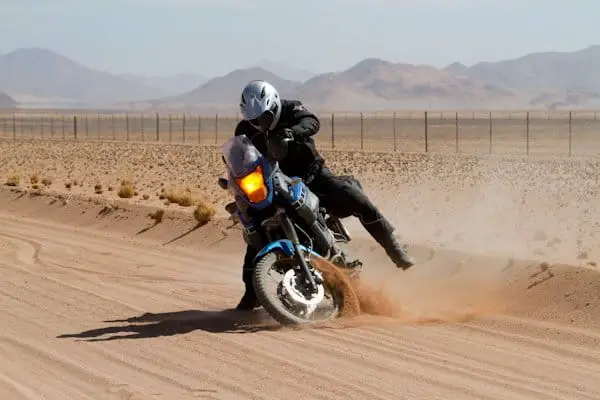
On a long distance adventure bike trip you are bound to encounter at least a small stretch of sand. If you venture further into the unknown, steering a heavy BMW R 1200 GS through rutted sandy tracks can really be demotivating. Make sure you practice the follow tips before you leave home.
The 3 top tips for riding a big adventure big through soft sand are: (1) look up to where you are heading, (2) stand up to lower the center of gravity, and (3) maintain your momentum by selecting the right gear. Practice makes perfect.
There are many tips and tricks on how to ride a big bike in sand. Here are the three tips that will make the biggest difference:
#1: Look up to where you are heading
One of the most common mistakes when riding in sand for the first time is to look at your front wheel. It is second nature to want to see what you are riding through and why your bike is feeling funny all of a sudden. You need to resist the urge to look down.
Instead, look far ahead towards where you are heading. Your whole body will adjust and aim the bike in that direction. It is the same principle when teaching a child to ride a bicycle for the first time. When I taught my daughter to ride last year, she kept looking down and could not keep the bike straight. As soon as she started look up she straightened out.
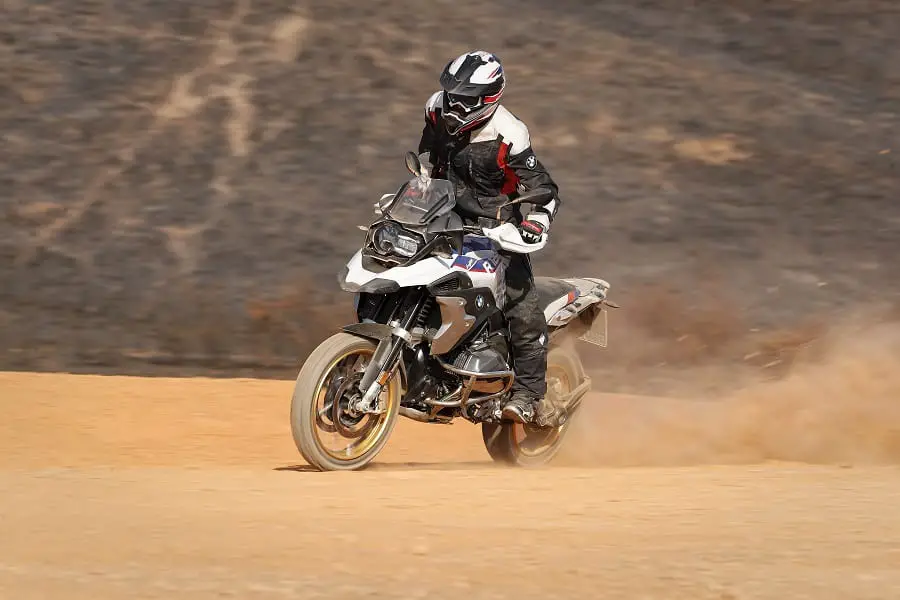
The same principle applies when want to cross, or get out of, a sandy rut left by a 4WD truck. Look ahead to where you want to end up. Do not fixate on the rut just in front of your wheel. Soon you will gain more confidence as you steer the bike in the direction you are headed.
Deep ruts left by trucks can make it really difficult to keep a big bike upright, never mind in a straight line. If it is possible (and there is no sensitive vegetation next to the road) you might try riding next to the tracks. But please be responsible. In many natural areas this is not allowed. In fact, in some areas like Northern Namibia, your tracks can stay there for decades.
#2: Keep your momentum
Whatever you do, try to keep your momentum. You don’t have to race through the sand at full speed. Going too fast can be very dangerous if you come off the bike. You just need enough speed to keep the bike moving forward. But not so fast that you struggle to concentrate on what is happening around you.
If the revs drops too low and the engine starts to struggle, you will have to downshift very quickly in order to not get bogged down. If the sand is thick enough, just pulling the clutch for a second will stop you in your track. Rather make sure you pick the correct gear before you hit the sand. Try and keep the revs high enough so that the bike has enough power to keep moving.
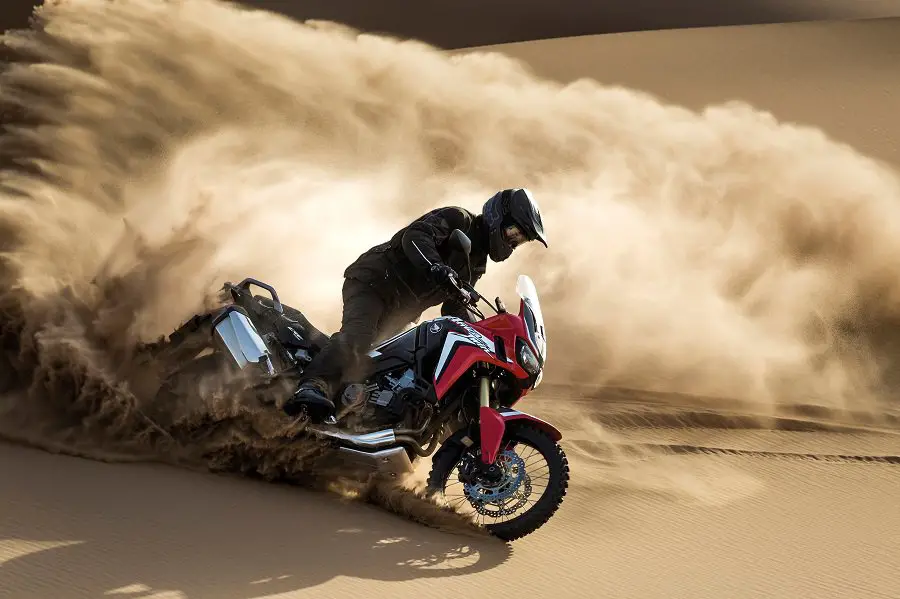
If you have to stop in the sand, do not hit the breaks. Just roll off the throttle gently or pull in the clutch. You don’t want the weight to suddenly shift to the front and dig in the wheel. If you have do an emergency stop, stomp on the rear brake and put your weight over the back wheel.
When you pull away in the deep sand, don’t ride the clutch. Rather drop the clutch and roll on the throttle while standing up on the pegs (see Tip 3 below).
#3: Raise your backside
If you look at the Dakar riders you’ll notice they are all standing up in the dunes. This is also what is taught in riding schools, like BMW’s riding academy. The idea is to lower the center of gravity by shifting the weight of your body from the top of the seat to the foot pegs. You don’t have to stand up straight as in some of the pics you see.
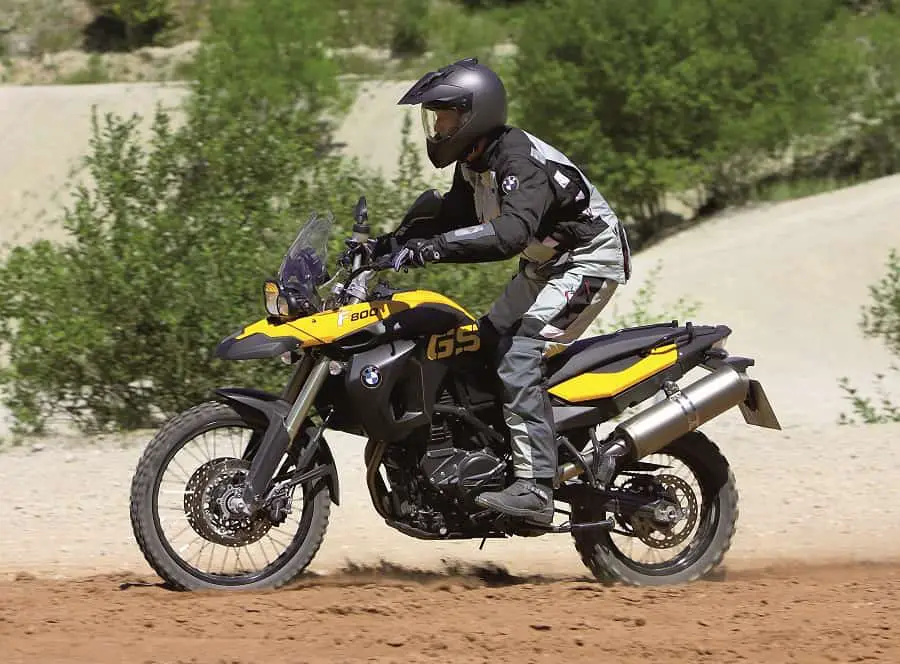
Bend your knees slightly to absorb the bumps. Make sure you stay relaxed so you can move your body around on the bike to keep the balance. This will allow the bike to self-correct as it weaves back and forth in the sand. If you are riding on a gravel road and spot a small patch of sand ahead, lifting your butt a few inches is enough to lift the weight off your seat and keep the front from going heavy.
Conclusion
Sand riding is much easier if you have fun. The more you tense up the less you will allow the bike to follow the tracks in the sand. Practice riding in soft sand until you gain confidence and start enjoying it. That way, when you hit a sandy section on a trip you won’t hesitate before taking it head on.
And remember. When you are on a long distance adventure bike tour your number one priority is to stay safe and not damage your bike. So if you have to sit and paddle your bike out with your legs dangling from either side, don’t be embarrassed. That is part of adventure motorcycling!
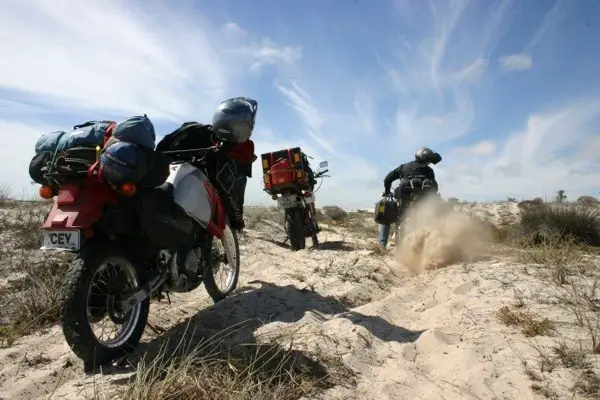
On our 3-month Crossing Africa trip we had to do quite a bit of sand riding on your cheap 200 cc Chinese road bikes. In this blog post we camped next to the Meroe pyramids north of Khartoum. Since there were no ruts we managed to easily ride on top of the sand by keeping the momentum. When my wife eventually got stuck in the deep, soft sand, she managed to easily get going again due to the light weight of the bike and the fact that she could plant both boots firmly on the ground.
Have fun and stay safe!
Oh, and remember to clean and lube your chain after dragging it through the sand all day.

